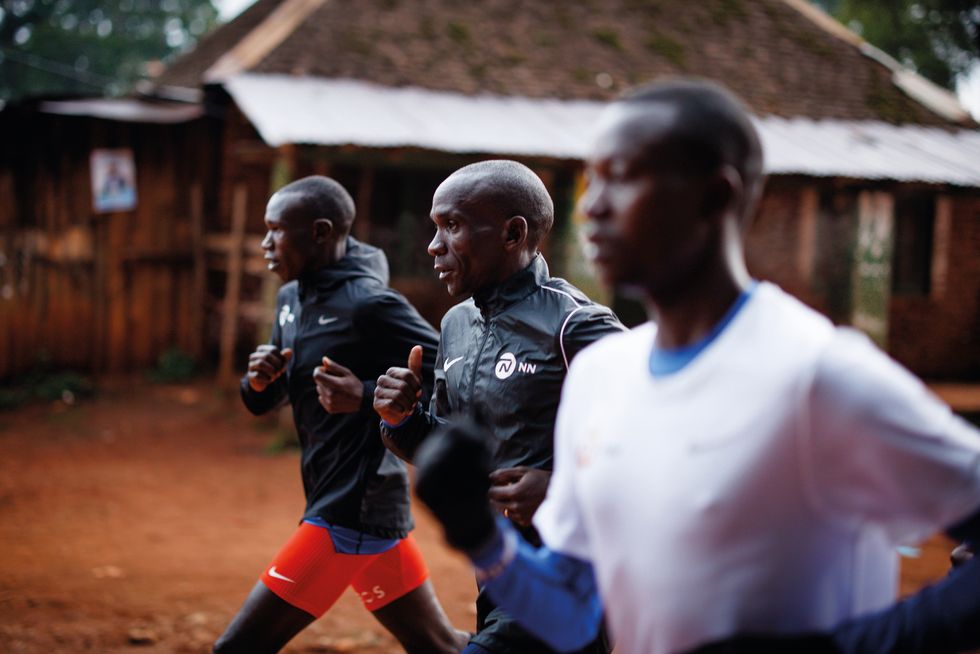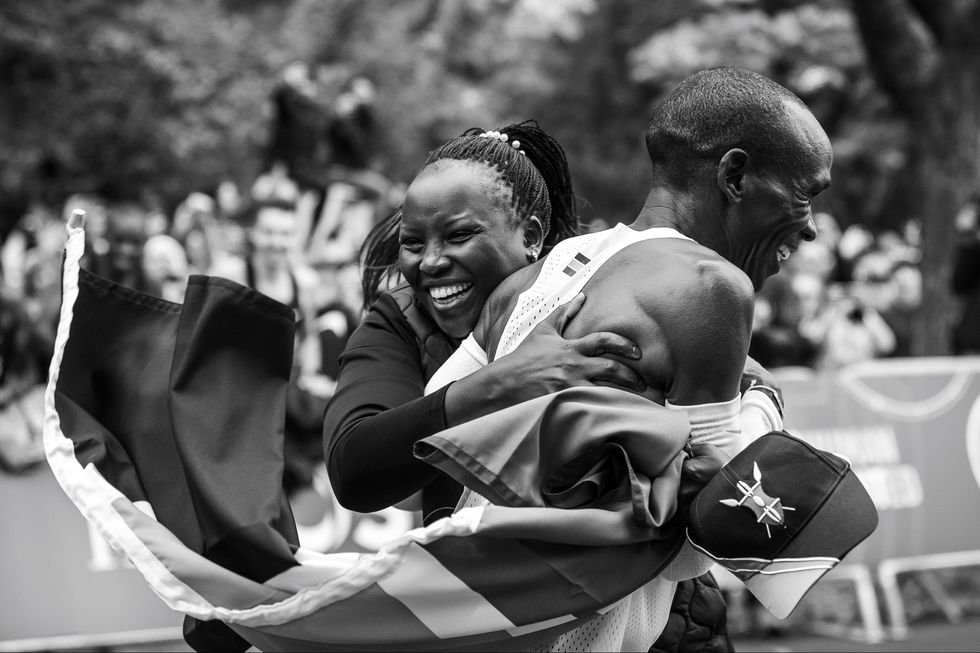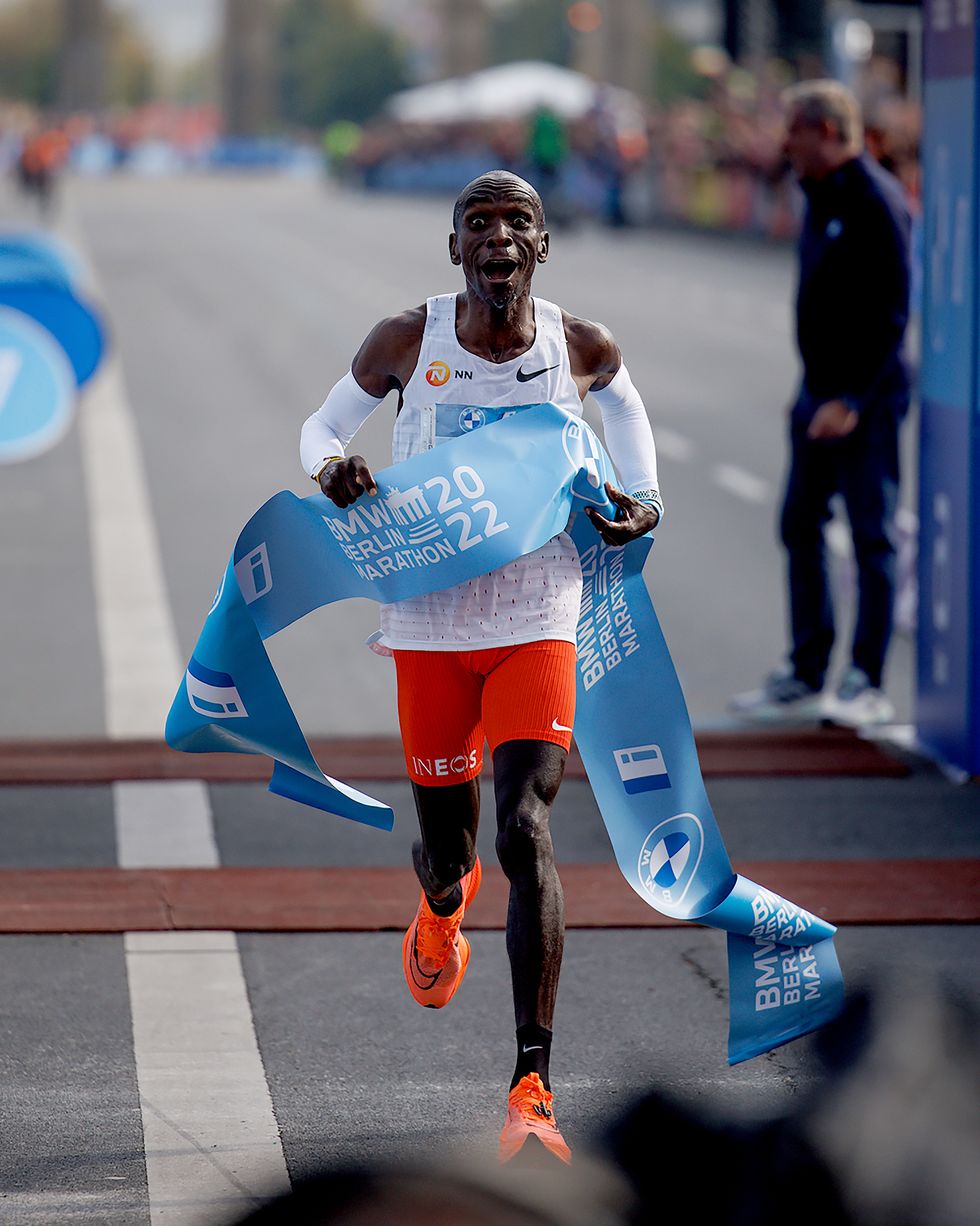This Is Kipchoge’s World And We’re Just Running In It
Past marathon legends showed us what was possible. Eliud Kipchoge made us believe in the impossible.
Everything is impossible until somebody does it.
Think about how many very recently unthinkable things we encountered today alone: the electric car you saw this morning, the tablet I’m tapping this out on, Flamin’ Hot Cool Ranch Doritos. They didn’t exist, they couldn’t exist, until they did.
Sometimes breakthroughs are the result of advanced technology. Sometimes they come from the exact right team of people with the exact right mix of skills. But sometimes the thing that brings it all together and makes it work is nothing more than pure will. Discipline. A defiant smile and a single step forward. And then, if this is a marathon we’re talking about, several thousand more steps forward.
For decades, physiologists said a sub-two-hour marathon was impossible. Then, in 2019, Eliud Kipchoge broke the very recently unthinkable two-hour-marathon barrier, completing the INEOS 1:59 Challenge in Vienna, Austria, in 1:59:40. I’d call it a quantum leap if I didn’t suspect that physicists had already started calling quantum leaps “Kipchoges.”
He carried us into a new world. It is, in fact, Kipchoge’s World, and we’re just running in it. Much more slowly.
“Sub-two-hours? It doesn’t seem real,” says marathon legend Bill Rodgers. “I remember when the physiologists said a human being can’t run [a marathon in] under two hours and two minutes.”
A little more than a decade ago, “people started to wonder whether we would see a sub-two happen, and I said it would happen in our lifetime,” says Meb Keflezighi, 2004 Olympic silver medalist in the marathon. “I just didn’t imagine it would be this soon.”
As the first Olympic women’s marathon gold medalist, Joan Benoit Samuelson knows something about breaking barriers, but even she had her doubts. “I used to think I couldn’t possibly be around when two hours was broken,” she tells me. But then along came Kipchoge. Very quickly. “When he first attempted to break two,” in Nike’s 2017 Breaking2 event in Monza, Italy, “I was actually there with Allyson Felix to hold the break tape. That was the first time I saw him, and wow. He’s just totally built for long-distance running.”
He didn’t make it that time — he finished with a time of 2:00:25 and had to settle for (unofficially) breaking a world record — but Benoit Samuelson ascribes exactly zero of that shortfall to Kipchoge himself. “It was a dark and lonely early morning when the race started, and if there had been as many people cheering in the first half as there were near the finish line, I think he’d have broken it there.” Take it from another game changer in the world of long-distance running: Eliud Kipchoge was ready, the world was not.

As the man himself says in the 2021 documentary Kipchoge: The Last Milestone, “The way you think about pain is the way your life will be. At the apex of pain, that’s where the success is.” It’s a little self-hypnosis, some mental jiu-jitsu, and it’s part of a zen approach to running that is pure Kipchoge.
Keflezighi credits Kipchoge’s greatness to his patience. “He’s been on top of his game for a long time; he didn’t just jump to the marathon. He naturally grew into it with a solid base of buildup, speed, and stamina.”
“You know, there’s the science of it, a runner’s VO₂ max and all that,” says professional runner Nico Montañez, “but I think his mind was there way before his body was.” And just as Kipchoge’s achievements have runners talking like scientists, they have PhDs talking like fans: “There is no doubt that Kipchoge is at the top of the world for his fitness, his VO₂ max, his lactate threshold, his mental stamina,” says Alison Marie Helms, PhD, a certified personal trainer and running coach. “But what truly sets him apart is the efficiency of his stride. Just watching him run, the fluidity of it is mesmerising. No energy is wasted.”
“You don’t see him being super aggressive in the race, or being the one to make moves early,” professional marathoner and running coach Dakotah Lindwurm says. “He stays calm and collected and sticks to his race plan.” She adds, “I actually took something from him, which is that you can smile through the pain. It’s easier to push through the pain if you are tricking yourself into thinking you’re enjoying it.”
“We all do the same sort of training, we recover the same,” Montañez says. “But mentality-wise, he’s leaps and bounds above everyone else, and we’re all trying to catch up.”
There is also, unique among internationally famous athletes, genuine humility. “There’s this photo that they published around Breaking2 where there was a list of the cleaning duties at his training camp,” says Robinson, “and Eliud’s name is on it.” He stops to let it sink in, maybe for himself. “Like, the greatest runner of all time is on his hands and knees scrubbing the toilet. The guy who cleans the toilet is the guy who broke two hours.”
That humility gives running coaches a new lesson for their athletes: “He could be living in a huge mansion and driving the nicest cars,” says Wes Miller, recently named NJCAA Assistant Coach of the Year for his work with the South Plains College track-and-field team, “but he just stays in his own lane and continues to train.” Kipchoge keeps it humble, even after achieving the superhuman, even as an actual museum is being built in his honor in Kenya. It’s a lesson Miller could try to teach his runners, he says — but it’s something only someone like Kipchoge could show them.

Kipchoge’s energy transcends the elite field and reaches the amateurs. Brian Oates has run the Boston Marathon for 27 years now, and he measures Kipchoge’s feat the way mortals — defined here as “still very good runners” — do: “The guy could run Hopkinton to Boston and back to the starting line before I’ve taken the right onto Heartbreak Hill.” Oates laughs, like the physical reality of it hits him as he’s saying it. “I mean, the guy is one of one.”
Kipchoge’s pace would be about a 21 kph on a gym treadmill, a speed that would blow most of us out the back wall of the gym if we tried it, which is why we’re lucky most commercial treadmills won’t even let us try. Kenny Santucci, who’s run the New York City Marathon five times and owns the gym The Strength Club NYC, thinks about Kipchoge when he’s training clients. “We’ll do a lot of sprints on the treadmill, and when you feel what that speed feels like, the idea of holding it for longer than 30 or 40 seconds is unreal. And Eliud’s out there living it for two hours.”
Rodgers set the first of his two American records in the marathon in 1975 at 2:09:55, just shortly after getting back into running to shock his lungs into shape after quitting smoking. The man knows a little about what the human body can achieve against the odds. “Kipchoge is just a phenomenal athlete, in track and in the marathon. He’s got fast-twitch and slow-twitch muscles, it seems.”
When the experts are proven wrong, often there is the sense of a dam breaking. “Nobody could do a sub-four mile until Roger Bannister did it,” Oates says. A month and a half after the barrier fell, Australian runner John Landy ran a mile in 3:58, and a year after that, three runners broke four in the same race at the British Games. After Bannister, Oates says, “then a whole bunch of people said, Oh, I can do that now.”
“Once the doors began to open for women in marathoning in the early ’70s, the barrier to break was three hours,” says Benoit Samuelson, “and then pretty quickly it was 2:20.” She added, “I think when people break out like this, it’s a positive influence on everyone.” He may not be able to share his VO₂ max with us, or his fast-twitch and slow-twitch muscles, or his tech, or his team. But we can all share his spirit.
As you watch a human being run a marathon in under two hours, it is fair to wonder whether there is anything a person can’t do. Keflezighi is contemplating that very thing. “We’re all stronger, faster, and quicker than we ever think, and sometimes we surprise ourselves, but there is a world we cannot go to, right? For a marathon, you can’t say one hour.” Keflezighi pauses, and so do I. Because of course you can’t. Can you?
Maybe that pause is what Eliud Kipchoge has really given the world. That moment of uncertainty that creeps in after we say, emphatically, that something cannot be done. In Kipchoge’s world, we’re all a little bit less certain that limits exist at all, that there is anything the human mind, will, body, and soul can’t accomplish. The experts and the veterans said a sub-two-hour marathon couldn’t be done. And they were right. Until Eliud Kipchoge did it.
What’s your sub-two? What’s the thing the voice in your head is insisting you cannot do?
I mean, that voice is right. For now.
Maybe tomorrow it won’t be.
Take it from Eliud Kipchoge: You can’t do it.
Until you can.
READ MORE ON: Eliud Kipchoge sub 2 marathon


